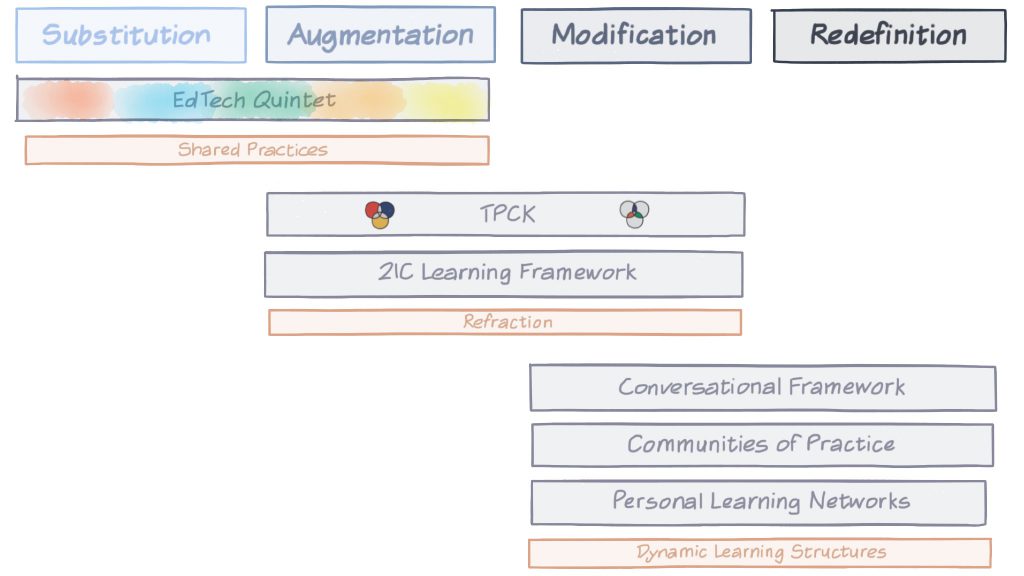Over the past fifteen years, I’ve had the good fortune of working with many people who have found SAMR a useful and helpful tool in their work. Over the same period of time, I’ve given quite a bit of thought to writing a book on SAMR and the EdTech Quintet, so as to share both models and their applications with a wider audience. Despite having created several drafts of such a book, I’ve always found a challenge in answering a simple question: what would make it special, and not just a restatement of what I’ve said elsewhere? After all, videos of my sessions are readily and freely available online, as well as all of the corresponding slides and other accompanying materials.
Some of my research work over these fifteen years has provided me with an answer. I’ve seen many successful and wonderful projects – but, unfortunately, I’ve also seen projects that never really take off, despite good availability of technology and technical support. In particular, I’ve seen projects that fail, not due to an excess of ambition, but rather due to an excess of caution. These projects are characterized by too gradual an approach, staying with Substitution-level uses almost exclusively during the initial phases, and failing to justify the time and resources used in the years beyond. Just presenting SAMR by itself does not help here: something more is needed, a solid scaffold that allows schools to incorporate Augmentation-level (and beyond) uses quickly, so that the project does not stagnate and fail in its early phases. The good news is that an approach that I’ve been testing over the past few years does just this – and this will then become the reason and subject of the book.
A (very rough) draft of the book is ready. Rather than editing the whole book in private, then publishing it as a finished whole, I’ve decided to fine-tune it in public, posting draft sections to this blog as they are completed, and making adjustments, additions, etc. based on what I hear back. The illustration above acts as a preview of the new, SAMR-derived scaffold; in book outline terms, it looks like this:
- Foundations: The Hows, Whys, and Wherefores of SAMR
- Theory Into Practice: Building SAMR Ladders
- Enriching the Toolset I: Mapping Technology with the EdTech Quintet
- Transitions – S to A: Shared Practices
- Theory Into Practice: SAMR Ladders, Shared Practice Rungs
- Theory Into Practice: Multiply Scaffolded SAMR Ladders
- Enriching the Toolset II: Facets of Transformation
- The Complementarity of SAMR and TPCK
- Design Choices and 21C Learning Frameworks
- Transitions – A to M: Refraction
- Theory Into Practice: Constructing Refracted Ladders
- Theory Into Practice: The Subject-Focused View
- Theory Into Practice: The Cross-Disciplinary View
- Enriching the Toolset III: Revisiting the Strength of Weak Links
- Conversational Frameworks and Social Networks for Learning
- Communities of Practice and Strong Links
- Personal Learning Networks and Weak Links
- Transitions – M to R: Dynamic Learning Structures
- Theory Into Practice: Enhancing Student Agency
- Theory Into Practice: Reframing Formative Assessment
- Theory Into Practice: SAMR Structures Beyond Ladders
- Theory Into Practice: Redefining Redefinition
- Appendix: SAMR and Research
- The Data and Methodology
- Conducting Your Own SAMR Research
I also have a series of topics that have come up in the writing of this work, and that don’t (yet) fit within the book plan. However, I would still like to share them with others, so I will also post about them here. A few of these topics are:
- What should computational thinking be about – and why should we care?
- The role of mobility today: revisiting the Lively Sketchbook and the Curiosity Amplifier.
- Architectural Redefinition: SAMR as a tool for designing learning spaces.
One final note: I have always made a point of making my slides and videos freely available and distributable under a Creative Commons BY-NC-SA license. That won’t change here: all of these blog posts are, and will remain under the same license. It is too important to me that as many people as possible have access to what I hope is useful information, rather than closing it off under lock and key.
See you next week, when the fun begins…
